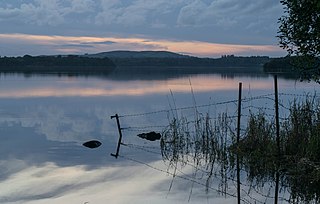Aughrim or Eachroim is the name of a number of villages in Ireland:

Stradone is a village located in County Cavan, Ireland. It is situated in the civil parish of Laragh six miles from Cavan, near the N3 road between Cavan and Virginia. Stradone is classified as a 'small village' in the Cavan County Council Development Plan 2014-2020.

Fairy forts are the remains of stone circles, ringforts, hillforts, or other circular prehistoric dwellings in Ireland. From (possibly) the late Iron Age to early Christian times, the island's occupants built circular structures with earth banks or ditches. These were sometimes topped with wooden palisades and wooden framed buildings. As the dwellings were not durable, in many cases only vague circular marks remain in the landscape. The remains of these structures, in conjunction with the vegetation around them, are associated with local traditions and folklore, perhaps involving fairies or other supposed supernatural entities, who would "defend" the structures from destruction by builders or farmers.
Lisnahederna is a townland located in County Cavan, Ireland. The name means the fort of the ambush. It is located in the parish of Mullagh, the barony of Castlerahan.

Agharaskilly is a townland in the civil parish of Tomregan, County Cavan, Ireland. It lies within the former barony of Loughtee Lower.

Fore is a barony in northern County Westmeath, Ireland. It was formed by 1672.
Moneensauran is a townland in the civil parish of Templeport, County Cavan, Ireland. It lies within the Roman Catholic parish of Glangevlin and barony of Tullyhaw.
Cabragh may refer to the following places:
Moherloob is a small townland in the civil parish of Templeport, County Cavan, Ireland. It is 0.45 square kilometres (0.17 sq mi) in area and lies in the barony of Tullyhaw. As of the 2011 census, there were no people living in Moherloob.

Stranadarragh is a townland in the civil parish of Templeport, County Cavan, Ireland. It lies in the Roman Catholic parish of Templeport and barony of Tullyhaw.

Port is a townland in the civil parish of Templeport, County Cavan, Ireland. It lies in the Roman Catholic parish of Templeport and barony of Tullyhaw.
Errigal Ringfort, also called Fort William, is a ringfort (rath) and National Monument located in County Cavan, Ireland.
Lisnagowan Ringfort is a ringfort (rath) and National Monument located in County Cavan, Ireland.
Cabragh Wedge Tomb, also called Cabragh I or the Giant's Grave, is a wedge-shaped gallery grave and National Monument located in County Sligo, Ireland.

Curraghglass, an Anglicisation of the Gaelic, ‘Currach Glas’ meaning The Green Moor, is a townland in the civil parish of Templeport, County Cavan, Ireland. It lies in the Roman Catholic parish of Glangevlin and barony of Tullyhaw.
Garvalt Lower, an Anglicisation of the Gaelic, ‘Garbhalt Íochtar’, meaning The Lower Rough Gorge, is a townland in the civil parish of Templeport, County Cavan, Ireland. It lies in the Roman Catholic parish of Glangevlin and barony of Tullyhaw.

Killaghaduff is a townland in the civil parish of Kinawley, barony of Tullyhaw, County Cavan, Ireland.
Aughnacliffe, officially Aghnacliff , is a village in County Longford, Ireland. It is located close to Lough Gowna and the border with County Cavan.

Castlerahan is a barony in County Cavan, Republic of Ireland. Baronies were mainly cadastral rather than administrative units. They acquired modest local taxation and spending functions in the 19th century before being superseded by the Local Government (Ireland) Act 1898.










